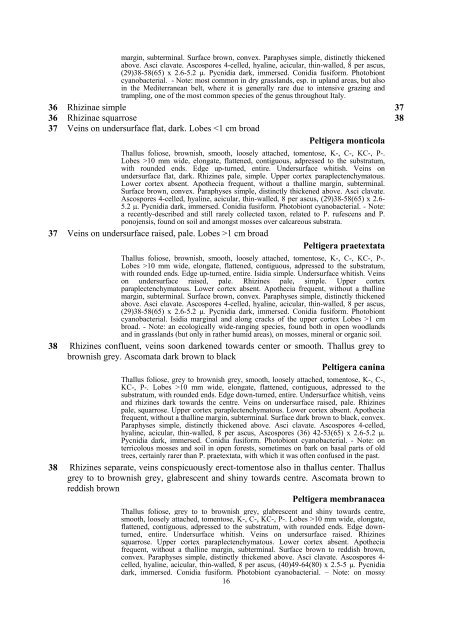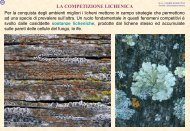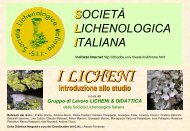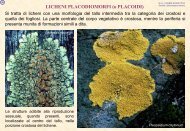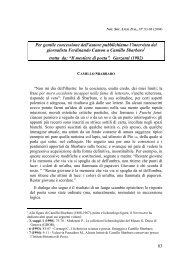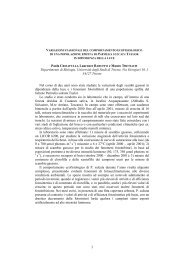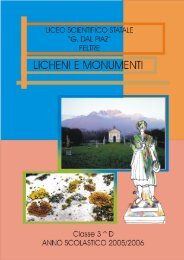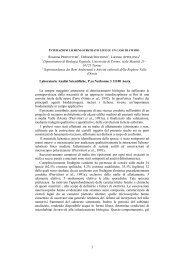KEY to terricolous lichens - italic
KEY to terricolous lichens - italic
KEY to terricolous lichens - italic
You also want an ePaper? Increase the reach of your titles
YUMPU automatically turns print PDFs into web optimized ePapers that Google loves.
36<br />
margin, subterminal. Surface brown, convex. Paraphyses simple, distinctly thickened<br />
above. Asci clavate. Ascospores 4-celled, hyaline, acicular, thin-walled, 8 per ascus,<br />
(29)38-58(65) x 2.6-5.2 µ. Pycnidia dark, immersed. Conidia fusiform. Pho<strong>to</strong>biont<br />
cyanobacterial. - Note: most common in dry grasslands, esp. in upland areas, but also<br />
in the Mediterranean belt, where it is generally rare due <strong>to</strong> intensive grazing and<br />
trampling, one of the most common species of the genus throughout Italy.<br />
Rhizinae simple 37<br />
36 Rhizinae squarrose 38<br />
37 Veins on undersurface flat, dark. Lobes 10 mm wide, elongate, flattened, contiguous, adpressed <strong>to</strong> the substratum,<br />
with rounded ends. Edge up-turned, entire. Undersurface whitish. Veins on<br />
undersurface flat, dark. Rhizines pale, simple. Upper cortex paraplectenchyma<strong>to</strong>us.<br />
Lower cortex absent. Apothecia frequent, without a thalline margin, subterminal.<br />
Surface brown, convex. Paraphyses simple, distinctly thickened above. Asci clavate.<br />
Ascospores 4-celled, hyaline, acicular, thin-walled, 8 per ascus, (29)38-58(65) x 2.6-<br />
5.2 µ. Pycnidia dark, immersed. Conidia fusiform. Pho<strong>to</strong>biont cyanobacterial. - Note:<br />
a recently-described and still rarely collected taxon, related <strong>to</strong> P. rufescens and P.<br />
ponojensis, found on soil and amongst mosses over calcareous substrata.<br />
37 Veins on undersurface raised, pale. Lobes >1 cm broad<br />
Peltigera praetextata<br />
Thallus foliose, brownish, smooth, loosely attached, <strong>to</strong>men<strong>to</strong>se, K-, C-, KC-, P-.<br />
Lobes >10 mm wide, elongate, flattened, contiguous, adpressed <strong>to</strong> the substratum,<br />
with rounded ends. Edge up-turned, entire. Isidia simple. Undersurface whitish. Veins<br />
on undersurface raised, pale. Rhizines pale, simple. Upper cortex<br />
38<br />
paraplectenchyma<strong>to</strong>us. Lower cortex absent. Apothecia frequent, without a thalline<br />
margin, subterminal. Surface brown, convex. Paraphyses simple, distinctly thickened<br />
above. Asci clavate. Ascospores 4-celled, hyaline, acicular, thin-walled, 8 per ascus,<br />
(29)38-58(65) x 2.6-5.2 µ. Pycnidia dark, immersed. Conidia fusiform. Pho<strong>to</strong>biont<br />
cyanobacterial. Isidia marginal and along cracks of the upper cortex Lobes >1 cm<br />
broad. - Note: an ecologically wide-ranging species, found both in open woodlands<br />
and in grasslands (but only in rather humid areas), on mosses, mineral or organic soil.<br />
Rhizines confluent, veins soon darkened <strong>to</strong>wards center or smooth. Thallus grey <strong>to</strong><br />
brownish grey. Ascomata dark brown <strong>to</strong> black<br />
Peltigera canina<br />
Thallus foliose, grey <strong>to</strong> brownish grey, smooth, loosely attached, <strong>to</strong>men<strong>to</strong>se, K-, C-,<br />
KC-, P-. Lobes >10 mm wide, elongate, flattened, contiguous, adpressed <strong>to</strong> the<br />
substratum, with rounded ends. Edge down-turned, entire. Undersurface whitish, veins<br />
and rhizines dark <strong>to</strong>wards the centre. Veins on undersurface raised, pale. Rhizines<br />
pale, squarrose. Upper cortex paraplectenchyma<strong>to</strong>us. Lower cortex absent. Apothecia<br />
frequent, without a thalline margin, subterminal. Surface dark brown <strong>to</strong> black, convex.<br />
Paraphyses simple, distinctly thickened above. Asci clavate. Ascospores 4-celled,<br />
hyaline, acicular, thin-walled, 8 per ascus, Ascospores (36) 42-53(65) x 2.6-5.2 µ.<br />
Pycnidia dark, immersed. Conidia fusiform. Pho<strong>to</strong>biont cyanobacterial. - Note: on<br />
<strong>terricolous</strong> mosses and soil in open forests, sometimes on bark on basal parts of old<br />
trees, certainly rarer than P. praetextata, with which it was often confused in the past.<br />
38 Rhizines separate, veins conspicuously erect-<strong>to</strong>men<strong>to</strong>se also in thallus center. Thallus<br />
grey <strong>to</strong> <strong>to</strong> brownish grey, glabrescent and shiny <strong>to</strong>wards centre. Ascomata brown <strong>to</strong><br />
reddish brown<br />
Peltigera membranacea<br />
Thallus foliose, grey <strong>to</strong> <strong>to</strong> brownish grey, glabrescent and shiny <strong>to</strong>wards centre,<br />
smooth, loosely attached, <strong>to</strong>men<strong>to</strong>se, K-, C-, KC-, P-. Lobes >10 mm wide, elongate,<br />
flattened, contiguous, adpressed <strong>to</strong> the substratum, with rounded ends. Edge downturned,<br />
entire. Undersurface whitish. Veins on undersurface raised. Rhizines<br />
squarrose. Upper cortex paraplectenchyma<strong>to</strong>us. Lower cortex absent. Apothecia<br />
frequent, without a thalline margin, subterminal. Surface brown <strong>to</strong> reddish brown,<br />
convex. Paraphyses simple, distinctly thickened above. Asci clavate. Ascospores 4celled,<br />
hyaline, acicular, thin-walled, 8 per ascus, (40)49-64(80) x 2.5-5 µ. Pycnidia<br />
dark, immersed. Conidia fusiform. Pho<strong>to</strong>biont cyanobacterial. – Note: on mossy<br />
16


